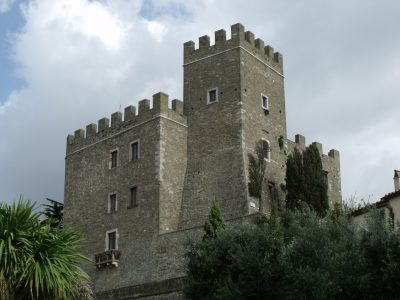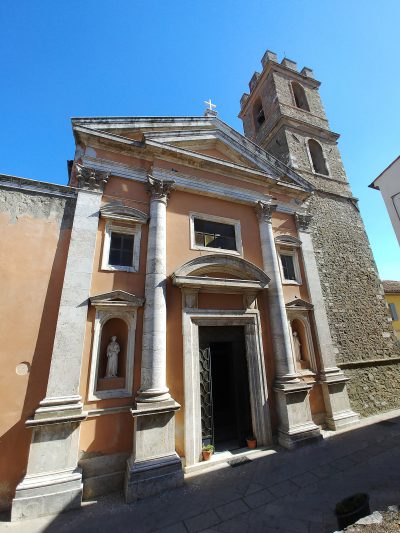Manciano is an Italian town in the province of Grosseto. The center stands on a hill which dominates the plain and the Albegna valley on one side and the Tufo area on the other.
Places to visit

Rocca aldobrandesca (Manciano)
•Rocca aldobrandesca di Manciano, built during the 12th century by the Aldobrandeschi family, was the subject of numerous disputes starting from the following century due to its strategic importance,
considered fundamental for the control of these lands. Occupied first by the people of Orvieto, the fortress passed to the Orsini di Pitigliano who controlled it until the 17th century, with the exception of a temporary Sienese dominion in the first half of the 15th century. Some restoration work was carried out by the grand dukes of Tuscany in the second half of the 18th century. Currently houses the seat of the Municipality of Manciano.

Aldobrandeschi fortress of Saturnia
•Aldobrandeschi fortress of Saturnia, built at the end of the 12th century by the Aldobrandeschi counts and rebuilt by the Sienese during the 15th century, today it is transformed. Within the area delimited by the walls, Castello Ciacci was built, built by the homonymous family in 1924 in neo-medieval style, with the crenellated tower which recalls the original medieval style of the remaining complex.
•Walls of Manciano: built by the Aldobrandeschi counts in the 13th century, in the same period in which the Aldobrandeschi fortress was being built, they were remodeled by the Sienese during the 15th century. Of the eleven watchtowers, only two are perfectly visible, while the others have been incorporated into buildings used for other uses: they are the Torre della Rampa, along via Trento, and the Torre di Porta Fiorella, above the entrance of the same name. They almost entirely delimit the historical nucleus of the center of the same name, which develops in the highest part of the hill.
•Walls of Montemerano: built by the Aldobrandeschi starting from the XII century, they were completed during the following century. Renovation works were carried out when Montemerano passed under the Republic of Siena, with the construction also of the Cassero complex, and in the Renaissance period, with the construction of the walkways. Along the walls there are today three doors, the door of San Giorgio, theporta Romana and the porta Grossetana.
The walls of Montemerano entirely delimit the village and are characterized by the overlapping of stylistic elements of the Middle Ages and Renaissance.
The defensive structure stretches of exposed curtain wall, covered in travertine and limestone, and other stretches incorporated into the external perimeter walls of some buildings in the centre.
•Walls of Saturnia: a first wall was built by the Romans during the 2nd century BC, on pre-existing Etruscan defensive structures. The Aldobrandeschi restructured and expanded the primitive circle at the beginning of the XIII century, at the same time as the construction of the fortress. The walls were rebuilt and redeveloped by the Republic of Siena in the mid-fifteenth century, while in the following centuries other changes led to the disappearance of three of the four ancient gates: the only remaining gate is the southern Porta Romana, with stone cladding and round arch opening, right in the crossing point of the ancient Via Clodia.
The walls of Saturnia largely enclose the village and present stylistic elements that unequivocally lead back to the various historical phases.
The curtain walls, despite being everywhere covered in stone, have features from the Roman era, mixed with elements from the medieval and Renaissance which are prevalent in the other stretches.
•Stachilagi Castle, located east of the hamlet of Marsiliana, on the top of a hill which dominates the Elsa stream valley, dates back to the 13th century and was built near the pre-existing Selva Abbey with adjoining monastery, dating back to the mid-12th century: the complex was part of the possessions of the Tre Fontane Abbey in Rome, which were enfeoffed by the Aldobrandeschi family. Abandoned after entering the Grand Duchy of Tuscany, it appears today in the form of ruins.
Stachilagi Castle, immersed in a thick vegetation, comes in the form of imposing ruins, with stone wall structures.

Church of San Leonardo
•Church of San Leonardo, dating back to the 14th century, it must have been in Romanesque-Gothic style. It was completely redone in 1932. In 1954 the new mosaic floor was built. Inside it preserves works of art such as the San Leonardo adoring the Holy Family ( 1894), the apostoli (1909) and the Good Friday by Paride Pascucci and a < strong class=”ui-sortable-handle”>travertine baptismal font from the first half of the 14th century.
On the right side, right next to the facade, stands the bell tower, which retains most of the original medieval stylistic elements. The bell tower is characterized by masonry structures in stone ashlars, divided into several orders by cordons, with a series of single lancet windows with round arches that open to the levels superior; the upper part culminates with a crenellation at the top.
• Clock Tower, bell tower located at the point where via Roma joins via Cavour, was built by the Sienese in the 15th century as part of the ancient Palazzo del Comune, now incorporated into the adjacent structures. After 1860 the plaque was placed in memory of the plebiscite of the annexation to the Kingdom of Italy.
•Castellum aquarum of Poggio Murella, large rectangular cistern with the interior divided into ten naves with barrel vaults and covered on the outside in opus reticulatum with dowels bichrome. Nearby you can find other remains from the Roman era.
•Museum of prehistory and protohistory of the Valle del Fiora, it was inaugurated in 1985 inside Palazzo Nardelli, a building built between 1824 and 1848 near the fortress aldobrandesca. The purpose of the museum is to document a long period of time ranging from Paleolithic to the Final Bronze Age in the territories of the Fiora valley.
•Necropolis of Puntone, a site frequented from the 7th to the 5th century BC, is made up of fifty tombs a chamber and a small number of pit graves.
Montemerano
Montemerano is a fraction of the Italian municipality of Manciano, it is located 6 km north-west of the municipal capital, along the road that leads to Scansano, and south of the spa town of Saturnia .
In the area there have been archaeological finds which testify to the presence of residential areas relating to the Neolithic period and Roman times. The place is also mentioned in documents dating back to the 9th century.
The characteristic medieval village was built during the XIII century by the Aldobrandeschi family on the highest part of the hill. In the fourteenth century the control of the town passed to the Baschi family, who led it to submit to Orvieto. During the 15th century Siena took possession of Montemerano and transformed it into an imposing fortress.
In the second half of the 16th century, with the definitive fall of the Republic of Siena, the center became part of the Grand Duchy of Tuscany, following its fate from that moment on.



